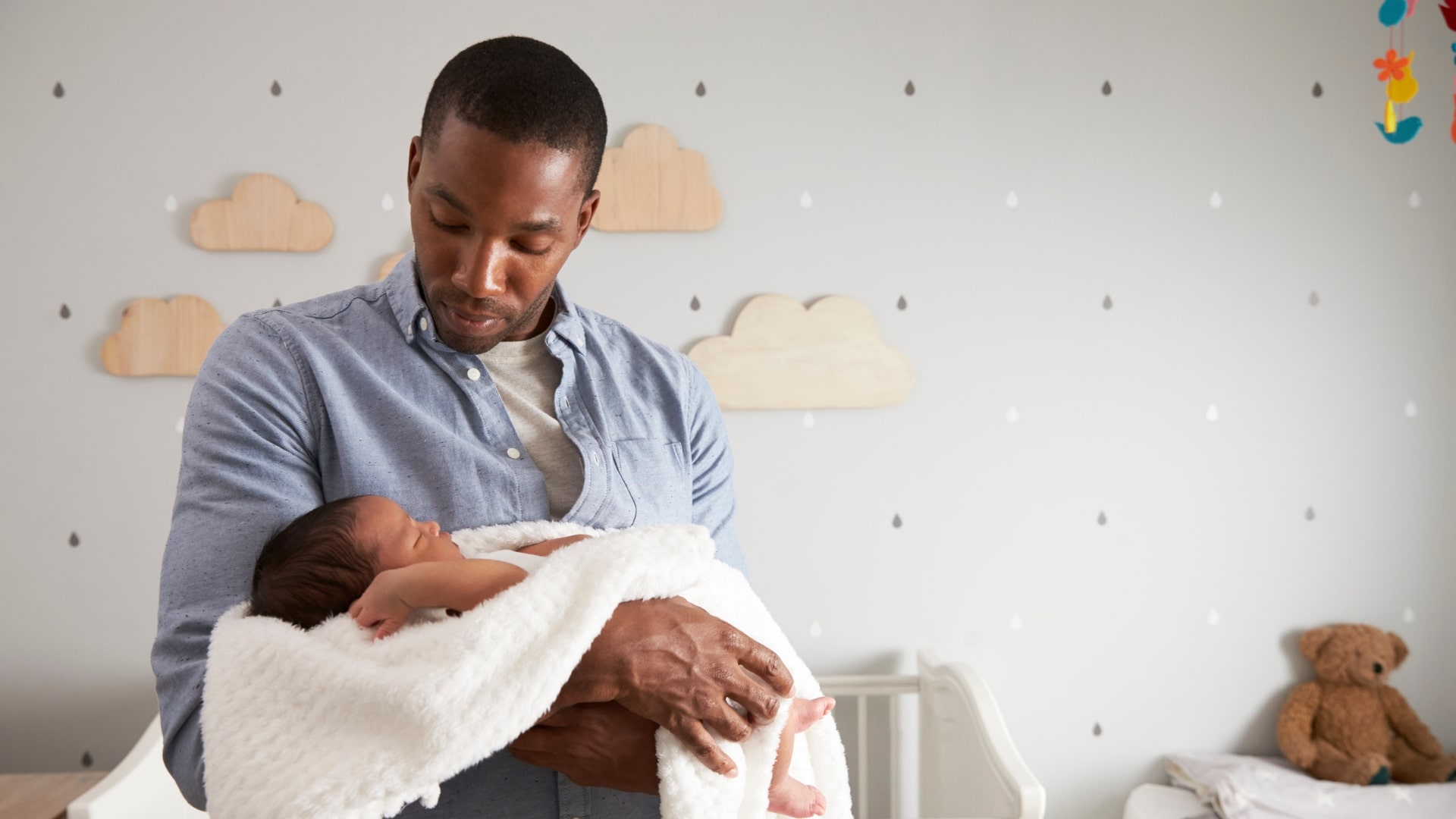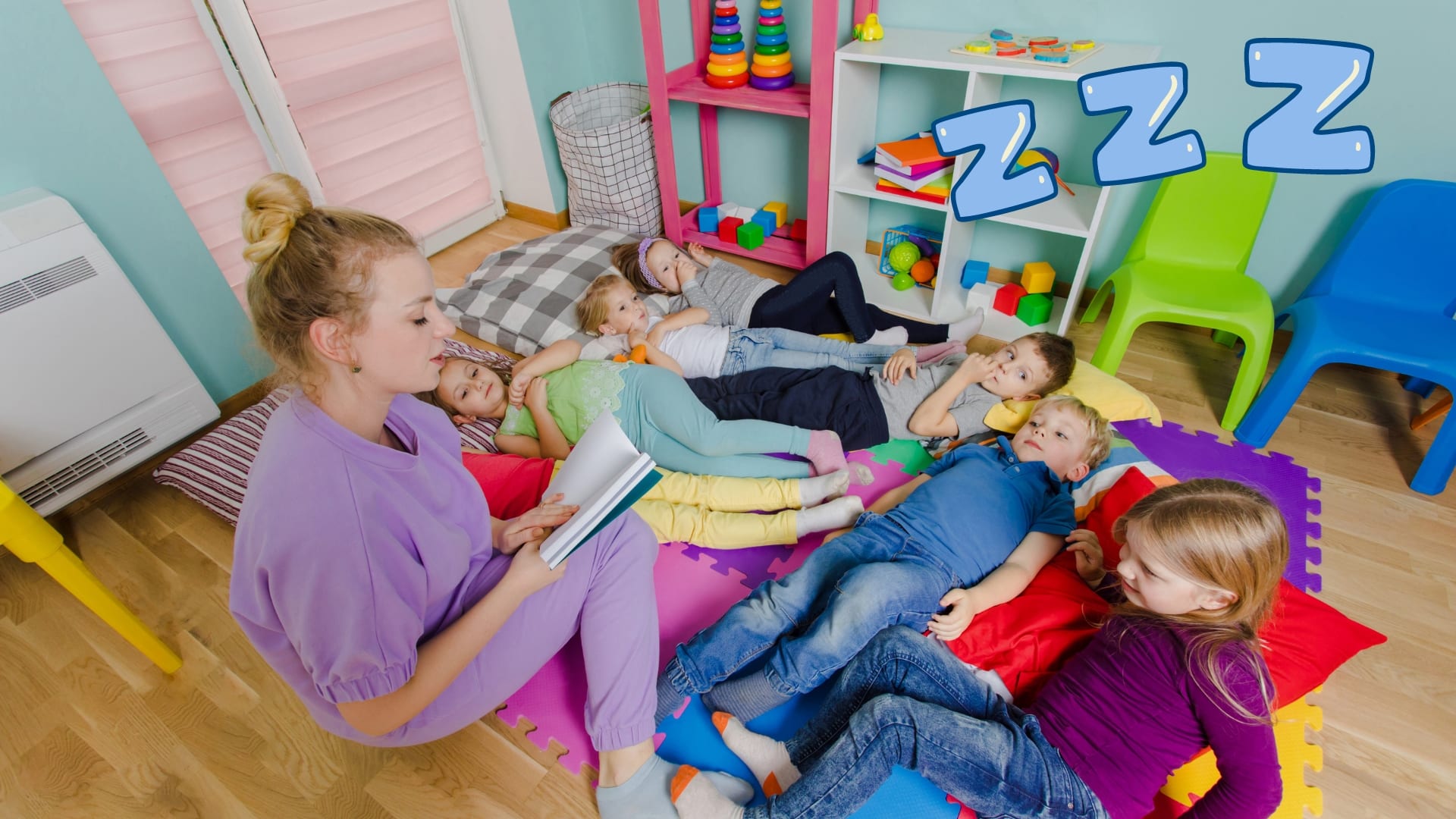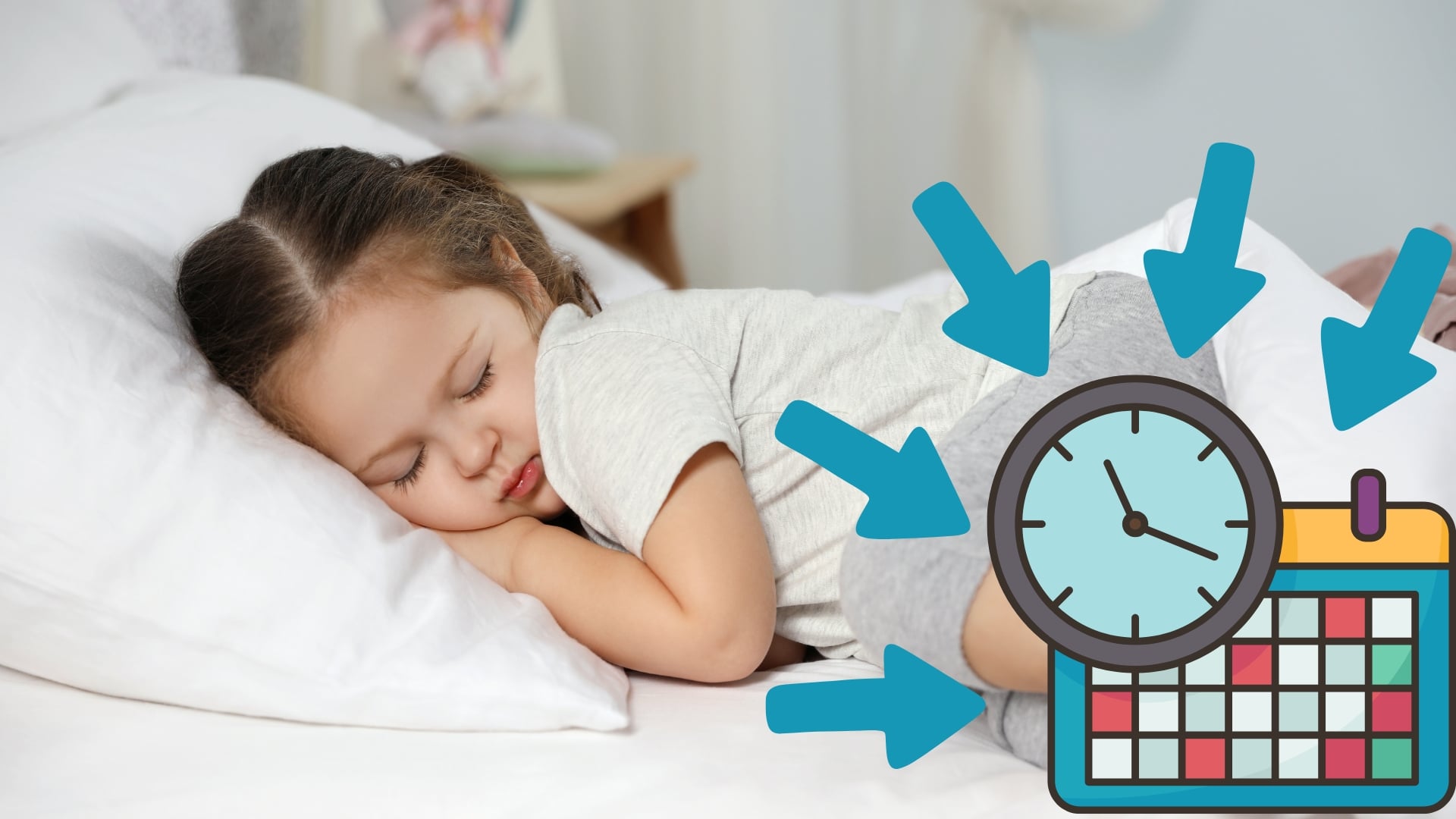Contact napping, or when a baby takes a nap while being held by an adult, is a popular practice among parents to help their baby fall asleep. But is it safe? Are there benefits? And what does it mean for you as a parent?

Table of Contents
Key Takeaways
- Contact napping is a safe sleep method for babies as long as the caregiver is awake and alert. It provides benefits like increased bonding and lowered stress levels.
- While common and beneficial in the short term, contact napping can create dependency issues in the long term if relied on exclusively. Babies need to learn to sleep independently as well.
- The ideal time to have transitioned away from contact napping is between 3-4 months, as babies are more developmentally able to self-soothe at this stage. However, every baby’s timeline is different.
What Is Contact Napping?
Contact napping is a sleep method that involves physical contact with a caregiver while a baby naps. It can take many forms, including skin-to-skin contact, snuggling, holding, or babywearing. It is mostly used for newborns and very young babies.
Is Contact Napping Safe?
As the American Academy of Pediatrics states and what I professionally agree with, it’s “imperative that the mother/caregiver who is providing skin-to-skin care be awake and alert.”
This is because the parent or caregiver must be able to monitor the baby’s breathing and ensure that their face is not obstructed… And these safety measures cannot be done when you’re asleep.
While contact napping can be a safe and comforting way for parents to bond with their baby, it is important to remember that it should not be the only method of napping in the long term. Letting babies gradually increase the amount of time they spend sleeping independently in a crib or bassinet is what I advise.
Therefore, if you do choose to contact nap with your infant, always ensure to have a safe sleeping environment to put them down to sleep on their own, should you need to.
Is Contact Napping Common?
Yes, contact napping is very common. A 2014 survey by BabyCenter found that 76% of mothers had practiced skin-to-skin contact after birth, which often led to contact napping in the months following. Many parents prefer contact napping as it is a wonderful way to connect and bond with their new baby.
Looking to get your little one to sleep quickly and effortlessly? Check out my Bedtime and Nap Cheat Sheet and master the art of making daytime naps and bedtimes as seamless as possible.
A bedtime & nap cheat sheet so good your little one will ask you to put them to bed...
Laura Williams "This is a life saver! I'm so glad I downloaded your bedtime & nap cheat sheet. My little one actually asked me to put him to bed last night! Unbelievable! Thank you so much!"
Click Here For The FREE Cheat Sheet
Benefits And Challenges Of Contact Napping
There is nothing more special than having your new baby fall asleep on you and I remember fondly how my son loved to fall asleep on my chest when he was first born.
While research into contact napping undoubtedly has its benefits for both you and your baby, it can also present issues moving forward.
So to help you decide whether contact napping is for you, here are the benefits and challenges you need to be aware of:
✅ Benefits Of Contact Naps With Baby
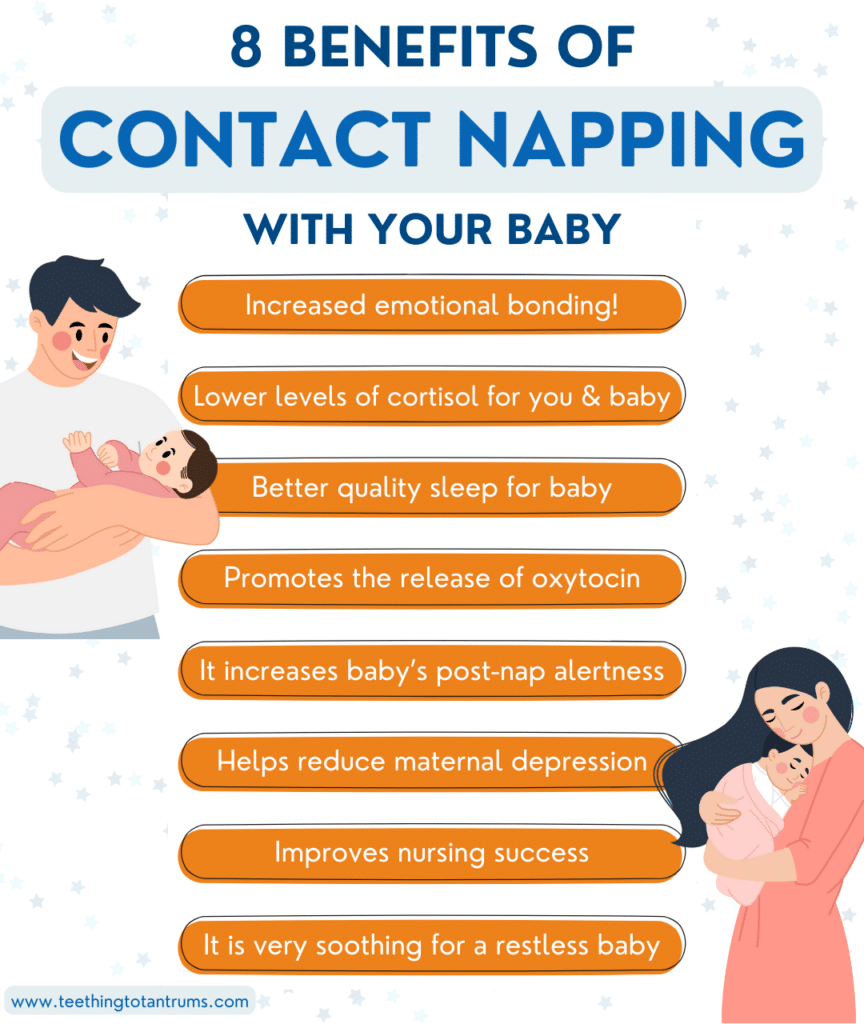
- Increased Bonding: Contact napping will help develop emotional bonding between you and your baby through physical contact and skin-to-skin.
- Lowers Levels Of Cortisol: Being in close physical contact can be beneficial for both you and your baby by reducing the stress hormone, cortisol, and allowing you both to relax and enjoy each other’s company. This can be very important if you had a difficult birth and are recovering or are struggling with breastfeeding and need some time to relax.
- Better Sleep Quality: Babies who contact nap tend to fall asleep faster and stay asleep longer because they’re warm, cozy, and feel safe.
- Increases Baby Alertness: Following on from the previous point, it has been suggested that contact napping can increase your baby’s alertness when they wake because they have had a deep and restorative sleep.
- Stimulates Oxytocin and Reduces Parent Blood Pressure: When a parent engages in contact napping with their baby, the physical closeness and touch release oxytocin, a hormone that helps reduce stress and lower blood pressure (also known as the feel-good hormone). The calming effect of contact napping can also lead to slower breathing and a sense of relaxation for both you and your baby.
- Can Help Reduce Maternal Depression: If you are struggling with post-natal depression, being physically closer to your baby can help alleviate your depression. Practicing contact napping is one way to help you bond more successfully with your baby in a relaxed and non-pressured environment.
- Can Improve Nursing Success: Some parents have found that contact napping can lead to more successful nursing. This is because when your baby is placed in skin-to-skin contact with you, it will help regulate baby’s body temperature, heart rate, and breathing, leading to improved breastfeeding outcomes. The release of oxytocin during contact napping also promotes milk letdown and helps establish a successful breastfeeding relationship.
- Soothing Method: Contact napping can be an effective soothing method for babies who have trouble falling asleep or staying asleep. The sound of your heartbeat and breathing will be very calming for your baby.
❌ Challenges Of Contact Naps With Baby
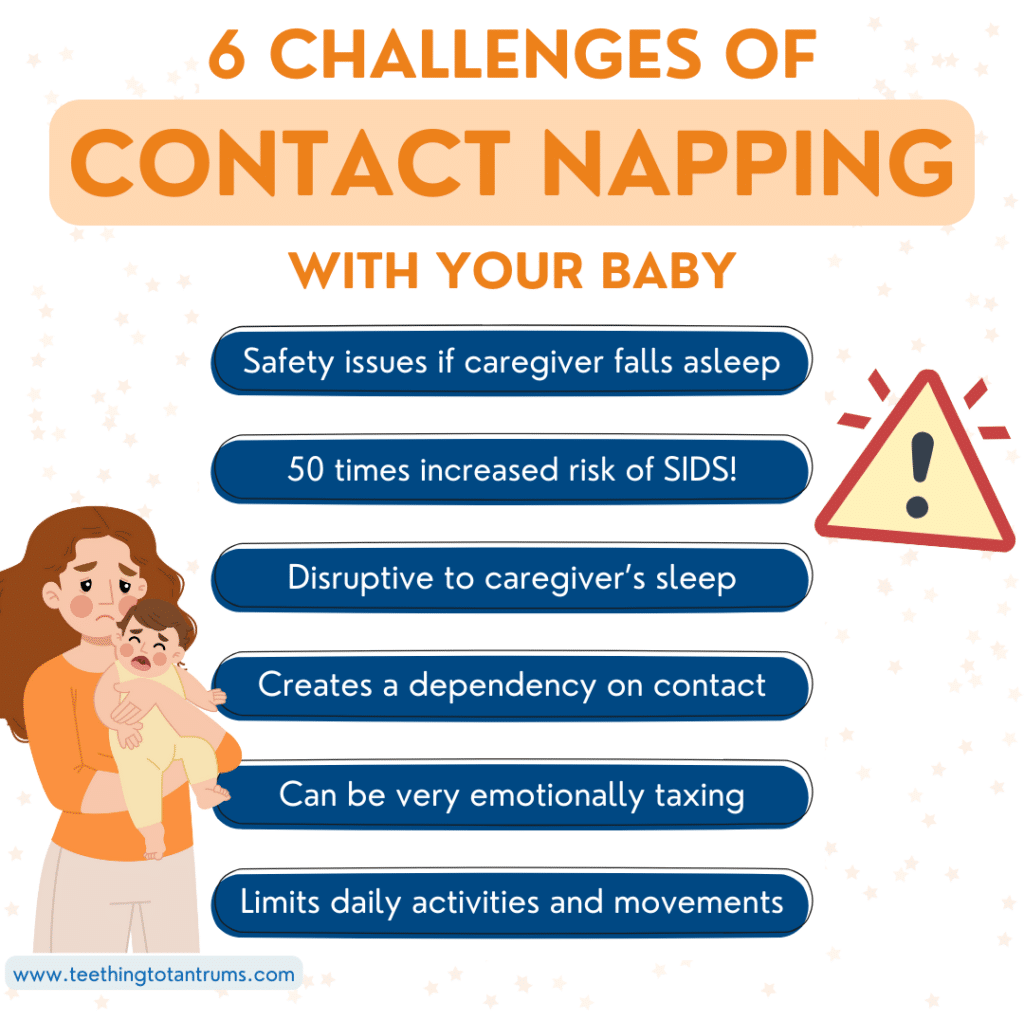
- Safety Concerns: Contact napping can be dangerous if the caregiver falls asleep in an unsafe position, the baby falls, or the baby rolls into a position from which they struggle to maintain a clear airway.
- Increased Risk of SIDS: Falling asleep on a sofa or armchair whilst holding your baby can increase the risk of SIDS by up to 50 times. In a survey of over 3,400 new parents, carried out by The Lullaby Trust, 40% of parents admitted to doing just this… Unwittingly putting their baby in danger by falling asleep together.
- Disruptive to Caregiver’s Sleep: Contact napping can be disruptive to the caregiver’s sleep, especially if the baby is awake frequently during the night. This can then increase the chance of the caregiver falling asleep when they are holding their baby, a precursor to the safety concerns outlined in my previous point. In one hospital, it was reported that over half of their nearly 300 neonatal falls occurred after a caregiver fell asleep while holding a newborn. Several more reports found that 36% to 66% of all in-hospital neonatal falls involved caregivers nodding off.
- Dependency on Contact Naps: Contact napping can become a bad habit if the baby becomes dependent on it to fall asleep. This can make it difficult to transition to independent sleep as baby grows (both in size and confidence)!
- Anxiety and Depression: Whilst some parents struggling with post-natal depression can find contact napping helpful… Others can find it emotionally taxing and difficult to do. If this is you, it is important to take care of your mental health and seek support to help you through this difficult time.
- Limitations on Daily Activities: Contact napping can limit your ability to engage in daily activities, such as household chores or running errands. This can be especially challenging if you have an older child to care for too.
Overall, contact napping can be a healthy and normal part of a baby’s sleep habits. However, it is important to have realistic expectations about how to do it and to always follow safe sleep guidelines.
If you are falling asleep, please put baby down in a prepared sleep space to keep them safe.
The worst may never happen, but you don’t want to take the risk.
How To Make The Most Of Contact Napping
Contact napping can be an essential part of the bonding process and there are things you can do to ensure its success.
To make the most of contact napping, preparation is essential.
Before baby is due for a nap, or when they start to show sleep cues, make yourself a cup of tea or coffee, and get a snack ready.
Choose a comfy spot and lay out all your supplies within arms reach. Settle in with your baby on you and help them drift off for a nap.
During this time you can read your book, watch a quiet TV show, or listen to some music on your headphones.
The aim should be to enjoy the moment, relax, and watch your little one sleep.
My essential supplies include:
- A cup of tea
- A bowl of prepared fruit and some dark chocolate
- A blanket
- Cozy socks
- Tissues
- My favorite book
Contact Nap Positions
There are several contact napping positions that your baby will more than likely fall asleep in. These include:
- Chest-to-chest hold: Baby lies face down on your chest with their arms tucked in. This position is the most common for small babies who contact nap. It is good for skin-to-skin contact and bonding. However, it can be difficult for you to monitor baby’s breathing, so make sure their head is slightly rolled to one side.
- Side-lying hold: In this position, you lie on your side with baby tucked into the curve of your body facing you. This allows for movement and skin contact. However, there is a risk of baby rolling away if not held securely. There is also a risk of you rolling onto baby, so use this position with caution.
- Cradle hold: Baby lies in the crook of your arm with their head and neck supported. This position keeps baby close to your chest but it can restrict movement. As a downside, your arm may fall asleep and go numb, limiting your ability to hold baby properly.
- Upright hold: In this position, baby sits upright on your lap, supported by arms around their back/chest, or baby is leaning against your thighs (when your legs are propped up). This napping position is good for reflux but there is less skin contact involved. It can also be tiring to hold baby upright for long periods.
TOP TIP: Babywearing is a form of contact napping that allows you to get on with chores both at home and when out and about. Carrying a baby in a sling or carrier can relieve the pressure of feeling tied to your home. However, the AAP does not recommend the use of infant carriers or infant slings for routine sleep. Babywearing for contact naps should be a backup, not a go-to.
How To Transition From Contact Napping
Transitioning from contact napping to independent napping can be a daunting task, but it is a necessary step towards independent sleep for your baby.
To make the transition smoother, quicker, and less stressful, here are my top tips:
- Gradual Transition: Start by slowly reducing the amount of physical contact during nap time. You can use a wrap or a weighted sleeping bag to make your baby feel more safe and secure in their crib or bassinet. Then gradually decrease the amount of time you spend settling your little and gradually increase the distance between you and your baby as they settle until they are comfortable sleeping on their own.
- Be Conscious With Your Timing: Avoid transitioning to independent sleep during times of illness, teething, or any other stressful event. Your baby will not appreciate having lots of changes happening at once!
- Put Your Baby Down Drowsy But Not Asleep: Practice makes perfect with this tip. Firstly, watch for sleep cues to make sure you are putting your little one down when they are ready for sleep. Then, start by holding your baby for a short while so they begin to fall asleep in your arms before putting them down to sleep. If, after lying down, your baby grizzles… leave them for a short while to see if they will self-soothe to sleep. If not, pick them up and repeat the process. Over time, gradually reduce the amount of time you hold baby before putting them down so they learn to fall asleep on their own.
- Practice When Awake: Allow your baby to practice being awake in their sleep space during the day when they are awake. Put up a crib mobile for them to watch. This will help your baby get used to their sleep environment and feel confident being in there by themselves.
- Sleep Environment: Ensure that your baby’s sleep environment is safe, comfortable, and conducive to sleep. This includes maintaining a comfortable temperature, using a white noise machine, singing a lullaby, and if need be, using black-out blinds.
- Bedtime Routine: You can start establishing a consistent bedtime and nap routine from very early on and the sooner you do, the better. Helping your baby associate certain activities with sleep is the best way to help them be primed for sleep. This can include a bath, storytime, and soothing methods such as rocking or singing for a short time before putting them down to bed (drowsy but not fast asleep)!
TOP TIP: If you don’t want to buy new swaddles and sleepsacks, placing a hand on your baby’s tummy (or holding their hand) can be a good first step to transitioning from contact napping to sleeping independently.
When Should Babies Stop Contact Naps?
Most babies start transitioning out of contact napping around 3-4 months old but many babies may go through the transition earlier.
Generally, by 3-4 months, your baby is more capable of self-soothing and their sleep schedule will become more consistent, making it the ideal time to stop contact napping.
Remember that every baby is different, and some may take longer to transition out of contact napping. It is okay to take it slow and follow your baby’s lead. Be patient and consistent, and eventually, they will learn to sleep without contact napping.
Frequently Asked Questions About Contact Napping
Looking for more information about contact napping? Here are the most frequently asked questions, answered just for you.
Q: Is it bad to always contact nap?
A: While contact napping can be a great way to soothe and bond with your baby, it is not recommended to always contact nap. It is crucial to encourage your baby to learn to sleep independently to avoid creating a habit that may be difficult to break in the future.
Q: Should newborn daytime naps be in the dark?
A: Newborns tend to sleep a lot during the day, and it is not necessary to keep the room dark during daytime naps. However, it is essential to ensure that the room is quiet and comfortable for your baby to sleep in.
Q: How can I encourage my baby to nap without contact?
A: Encouraging your baby to nap without contact can be challenging, but it is possible. Start by creating a consistent nap routine, such as dimming the lights and playing soothing music. You can also try swaddling your baby or using a pacifier to help them fall asleep.
Q: How many contact naps a day is OK?
A: The number of contact naps a day that is okay for your baby depends on their age and individual needs. Generally, newborns may need up to six contact naps a day, while older babies may only need one or two contact naps.
Q: Why do babies sleep better when held?
A: Babies sleep better when held because they feel safe and secure in their parent’s arms. The warmth and comfort of being held can also help to regulate their breathing and heart rate, leading to a more peaceful sleep.
Q: Do babies sleep longer with contact naps?
Not always. If your baby normally takes short naps, then contact napping can help to extend these naps. But if your baby naps for a long time already, their nap length will not change.
Remember, during skin-to-skin contact, most newborns easily fall asleep within a few minutes – and they achieve deep sleep for an hour or more, which is especially beneficial to a baby’s developing brain.
Need More Parenting Help?
- Download our FREE Perfect Sleep Cheat Sheet. It’s a free, easy-to-use and proven formula designed for parents of 0-5 year olds to master the art of consistently undisturbed and restful sleep without the yelling, nagging or exhausting long-winded evenings.
- Check out our Parenting Toolbox. You’ll get access to expertly-chosen products that you can guarantee are the best for your little one and your wallet.
- Ready to create the calm, peaceful evenings you deserve? Then checkout our most popular course - The Bedtime Battles Masterclass

A bedtime & nap cheat sheet so good your little one will ask you to put them to bed...
Laura Williams "This is a life saver! I'm so glad I downloaded your bedtime & nap cheat sheet. My little one actually asked me to put him to bed last night! Unbelievable! Thank you so much!"
Click Here For The FREE Cheat Sheet
